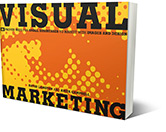Visual Marketing: 99 Proven Ways for Small Businesses to Market With Images and Design, is our new book
Visual Marketing: 99 Proven Ways for Small Businesses to Market With Images and Design, is our new book written by communications strategist David Langton and Anita Campbell, Publisher and CEO Small Business Trends. Here is an interview by By Ivana Taylor that appeared on SmallBizTrends.com
Tell us a bit about Nothing.org’s campaign (p. 138). What caught your attention about it?
Anita Campbell: Nothing.org is a regional bank food and a small nonprofit. “Nothing” refers to having nothing to eat.
 The marketing campaign depicting a can of nothing (i.e., a food can with the label “Nothing” on it) has meaning on several levels.
The marketing campaign depicting a can of nothing (i.e., a food can with the label “Nothing” on it) has meaning on several levels.
First, there’s an obvious play on words with a can of “nothing.” You expect a can to hold something. This one held nothing.
Then you also have the wit involved with how do you visually convey “nothing”? I mean, how do you draw “nothing”? It’s hard. You need more than words to make an impact you need an image. So there needed to be a way to make “nothing” seem tangible, to get people to donate. And since it is a food bank where people donate cans of food, the food can of nothing had double meaning.
It seems many of the selected examples found ways to gain interest from items we think are declining in popularity, like GGRP’s using 45 records (p. 86). Do you think these choices makes for a great long-term strategy?
Anita Campbell: GGRP is a recording studio. For a marketing campaign they created a mailer made of cardboard that you assembled into a 45 record player. They included a vinyl 45-rpm record showcasing their recording capabilities. What’s a 45-rpm record, you ask? It’s how people used to listen to music before iPods. Really old technology.

The takeaway from GGRP’s strategy is not that it uses out-of-date technology. It was intentionally retro to get attention. And the retro technology related specifically to the business GGRP is in, so it was relevant.
No, the real learning is that when doing direct mail, send out interactive “lumpy mail.” You may quickly forget a letter or postcard, no matter how well written. But aren’t you likely to remember a 45-rpm record player that you had to take a few minutes to assemble, and the message you heard using it?
Creativity like that never goes out of date.
Speaking of creativity, we wanted to get David Langton’s advice on using visuals in marketing.
What advice would you give small business owners who want to embark on a marketing project, but don’t know where to begin?
David Langton: I always tell businesspeople, “Get professional help!” And I don’t mean therapy. Yet, creating a brand for your company is a lot like therapy. You must get in touch with the core reasons your business exists and create a brand that encompasses the core values and services you offer in ways that are attractive and distinctive to your primary audience
 Gretchen Ditto is an image consultant but just because she is an expert in establishing style and presentation for her clients does not mean she is a marketing or communication designer. She turned to professional designer Katrina Hase of Mix Creative to produce a new brand that has the right balance between casual and professional for Ditto & Co. Her brand provides a communication positioning that has increased her status as a speaker and a consultant.
Gretchen Ditto is an image consultant but just because she is an expert in establishing style and presentation for her clients does not mean she is a marketing or communication designer. She turned to professional designer Katrina Hase of Mix Creative to produce a new brand that has the right balance between casual and professional for Ditto & Co. Her brand provides a communication positioning that has increased her status as a speaker and a consultant.
What are pitfalls marketers should avoid when they are thinking of doing a visual marketing campaign?
David: The biggest pitfall I see is that small businesses try to be everything to everybody. Focus on what you do best. Your business is defined by what you do and by what you choose not to do. Success comes when you define what you do best and then deliver that service to a specific audience.

Paula Bodnar Schmitt of the Bodnar Design Consultancy designed an abstract sign featuring the musical symbol for “quarter note” for the Quarternotes Loft apartments. This targeted music students and professionals who would certainly be aware of the meaning of the quarter note symbol as well as the clever wordplay on “living quarters.” By using the musical symbols, they targeted their message to the audience they wanted to reach, and the apartments were fully rented.
What are the core design elements that have to be present for a campaign to be successful?
David: The core design elements for creating a successful campaign are:
Style: The design or look and feel of the campaign should reflect the theme of your services and resonate with your target audience. Style elements include shapes, color, imagery and typography.
Meaning: What does the artwork or campaign mean? Does it reflect the mission of your organization? Is copy well-written, succinct and easy to understand?
Function: Does the design drive business? Change behaviors? Motivate or challenge your audience to take action?
All three elements must support each other. Your style should have meaning that supports the functions or goals and objectives of your campaign.
Renaissance Capital IPOThe Renaissance Capital identity is a good example of how all three elements work together in a successful identity and marketing campaign. Renaissance Capital is a research firm that specializes in Initial Public Offerings (IPOs). They believe that the founders and innovators of new companies like eBay, Google and Facebook are the “Renaissance people” of today.
 The new logo designed by my firm (Langton Cherubino Group) takes the letters I-P-O and evokes the style of a Greek Revivalist ionic column. By combining the heritage of Renaissance design with a modern style, the brand positions this research firm as the go-to source for IPO content. The new design, which also includes a streamlined and reorganized website, caught the attention of the Financial Times Stock Exchange (FTSE), which has become a partner in offering services to a new market in Europe.
The new logo designed by my firm (Langton Cherubino Group) takes the letters I-P-O and evokes the style of a Greek Revivalist ionic column. By combining the heritage of Renaissance design with a modern style, the brand positions this research firm as the go-to source for IPO content. The new design, which also includes a streamlined and reorganized website, caught the attention of the Financial Times Stock Exchange (FTSE), which has become a partner in offering services to a new market in Europe.
What are the biggest mistakes marketers make when they create campaigns and what’s your advice on how to fix them?
David: The biggest mistake is to think that you are your best client. Designing a visual marketing campaign or identity should not be based on what you personally like. It should be about how your company and services are positioned for your target audience. Your visual marketing should be created to attract and persuade the people who buy your services.
Time and time again, clients think that they can design it themselves. It’s important to step back and try to think like your own clients. Present your objectives and goals to your designers and marketing experts and let them present creative visual solutions back to you. Let the creatives be creative and perhaps you will be surprised by fresh and innovative ideas that you never would have come up with on your own.
What do you want readers to ultimately “get” from the book?
David: Visual Marketing is an “idea trigger” book. It gives you ideas for how to spice up your marketing, using images and design. If you walk away with just one or two new ideas, those ideas could result in tens of thousands of dollars or more in new business and profit. In that case, Anita and I have done our jobs, and thumbing through Visual Marketing will be well worth it.
You can find out more at the Visual Marketing Book website or follow on Twitter for updates at @VisualMktgBook. Back to Insights



